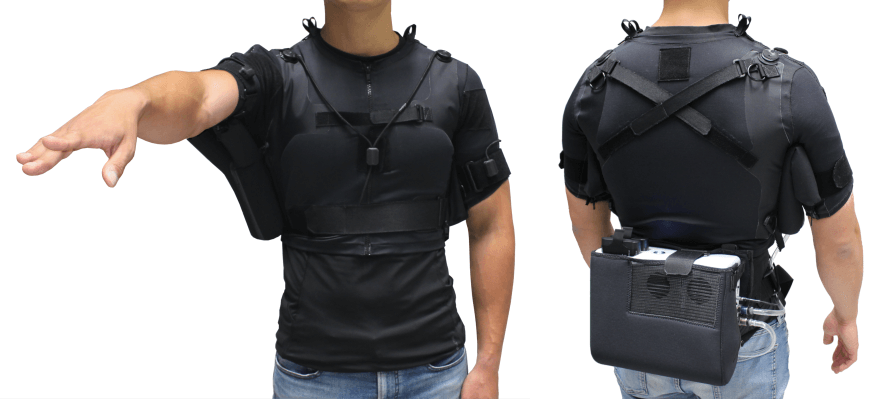
People with ALS can wear this prosthetic for assistive arm movement. (Image Credit: Walsh Lab, Harvard SEAS)
Approximately 30,000 people in the United States suffer from ALS, a disease that damages the brain and spinal cord cells responsible for movement. Researchers at the Harvard John A. Paulson School of Engineering and Applied Sciences (SEAS) and Massachusetts General Hospital created a robotic prosthetic designed to help patients suffering from ALS move their upper arm and shoulder.
"This technology is quite simple in its essence," says Tommaso Proietti, the paper's first author. "It's basically a shirt with some inflatable, balloon-like actuators under the armpit. The pressurized balloon helps the wearer combat gravity to move their upper arm and shoulder."
The wearable features a sensor system responsible for detecting arm movement and calibrating the correct balloon actuator pressurization for smooth arm movement. Ten patients diagnosed with ALS participated in the study, wearing the device to determine its overall effectiveness. The researchers discovered it provided a better range of motion while decreasing muscle fatigue and enhancing varying task performance, such as holding objects. Participants learned to use the device in under 15 minutes.
"These systems are also very safe, intrinsically, because they're made of fabric and inflatable balloons," Proietti says. "As opposed to traditional rigid robots, when a soft robot fails, it means the balloons simply don't inflate anymore. But the wearer is at no risk of injury from the robot."
In addition to it being battery-powered, the wearable is lightweight, providing more comfort to the wearer. "Our vision is that these robots should function like apparel and be comfortable to wear for long periods of time," he says.

Balloon actuators provide a natural and smooth arm movement. (Image Credit: Walsh Lab, Harvard SEAS)
The researchers are working with neurologist David Lin to create rehabilitation applications for those who suffered from a stroke. Additionally, this technology could be used for patients with muscular dystrophy or spinal cord injuries."As we work to develop new disease-modifying treatments that will prolong life expectancy, it is imperative to also develop tools that can improve patients' independence with everyday activities," says Sabrina Paganoni, one of the paper's co-authors, who is a physician-scientist at MGH's Healey & AMG Center for ALS and associate professor at Spaulding Rehabilitation Hospital/Harvard Medical School.
However, this prototype only works with those with limited shoulder residual movement. ALS progressively worsens over a two to five-year period. At that point, patients lose their ability to speak or swallow. Collaborating with MGH neurologist Leigh Hochberg, the team is looking into assistive wearables, in which the brain signals are used to control the movements. They hope a device like this could assist those without any residual muscle activity.
The researchers are enthusiastic to see how this technology could improve patients' lives. They also warn that they are still in the research stage, and the technology will be ready for commercialization in several years. "Soft robotic wearables are an important advancement on the path to truly restored function for people with ALS. We are grateful to all people living with ALS who participated in this study: it's only through their generous efforts that we can make progress and develop new technologies," Paganoni says.
Have a story tip? Message me at: http://twitter.com/Cabe_Atwell
